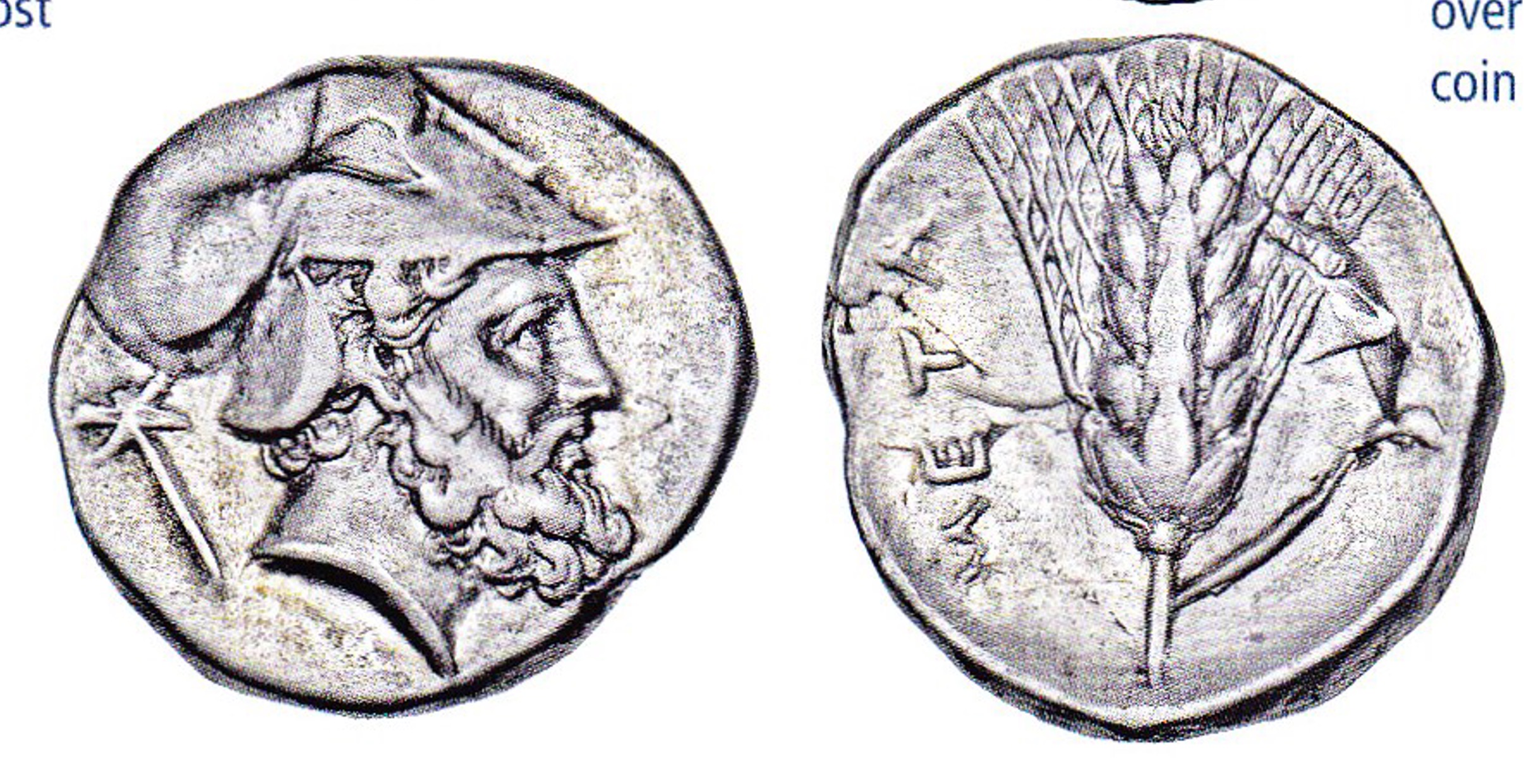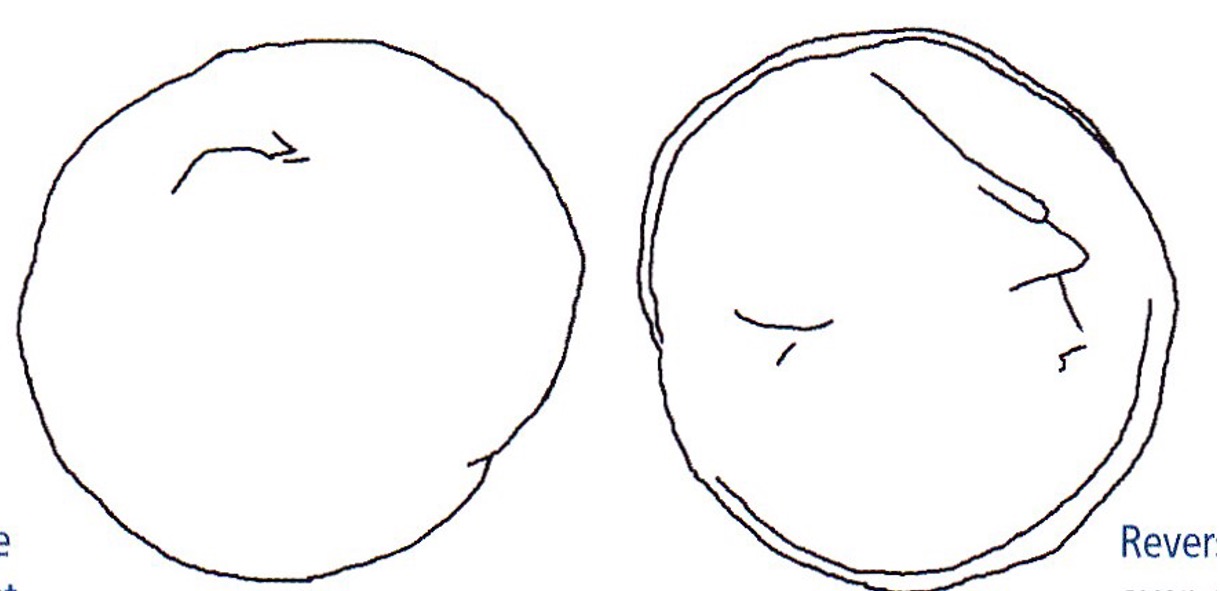1926 - Metapontum (nomos Leucippus/ear of barley) over Corinthian type (Pegasus/Athena) (MacDonald coll. 18)
From SILVER
339 BCE - 330 BCE | META
Images
Overstruck variety Traces of the overstruck variety
Traces of the overstruck variety

Pegasus Corinth Aphrodite helmet.jpeg [1]
Location/history
| Private collection(s)Private collection(s) ᵖ: | David MacDonald collection, n° 18 |
Overstriking coin
Description
| ObverseInscription or printing placed on the obverse.: | Head of Leucippus right, wearing Corinthian helmet. In field, cross-torch. | ReverseInscription or printing placed on the reverse.: | META (Greek) Ear of wheat with leaf. In right field, I-H. |
Mint and issuing power
| MintIdentifies the place of manufacture or issue of a numismatic object.: | Metapontum | Ancient regionAncient region. | Lucania | Modern countryModern country: Italy | AuthorityIdentifies the issuing power. The authority can be "pretended" when the name or the portrait of X is on the coin but he/she was not the issuing power. It can also be "uncertain" when there is no mention of X on the coin but he/she was the issuing power according to the historical sources: |
Chronology
| FromIdentifies the initial date in a range assigned in a numismatic context. 339 BCE toIdentifies the final date in a range assigned in a numismatic context.. 330 BCE | Classical 480-323 BC |
Physical description
| MetalThe physical material (usually metal) from which an object is made.: Silver |
WeightWeight of the numismatic object (in grams). in grams: 7.627.62 g <br />7,620 mg <br /> | DenominationTerm indicating the value of a numismatic object. Examples: tetradrachm, chalkous, denarius.: nomos | AxisDescribes the directional relationship between the obverse and reverse of a numismatic object.: 1010 mm <br />1 cm <br /> |
| StandardStandard.: Achaian | |||
References
| Coin referenceReference of the Coin: | MacDonald 2009, p. 26, n° 18 | Coin series referenceReference to coin series study: | MacDonald 20091MacDonald 2009, p. 26, n° 18, HN Italy2HN Italy, n° 1555., HGC 13HGC 1, n° 1055 |
| Coin series web referenceCoin series web references: | |||
Overstruck type
Description
| ObverseInscription or printing placed on the obverse.: | Pegasus flying left. Belo, mintmark (visible: traces of helmet). | ReverseInscription or printing placed on the reverse.: | Head of Athena right, wearing Corinthian helmet (visible: outline of nasal guard and lower edge helmet and profile of Aphrodite to tip of nose. Under magnification, outline of chin and neck of Aphrodite, bottom of helmet bowl in left field). |
Mint and issuing power
| MintIdentifies the place of manufacture or issue of a numismatic object. ᵖ: | Corinth | Ancient regionAncient region. ᵖ | Peloponnesus | Modern countryModern country: Greece | AuthorityIdentifies the authority in whose name (explicitly or implicitly) a numismatic object was issued. ᵖ: |
Chronology
| FromIdentifies the initial date in a range assigned in a numismatic context. 380 BCE toIdentifies the final date in a range assigned in a numismatic context.. 340 BCE | Classical 480-323 BC |
Physical description
| DenominationTerm indicating the value of a numismatic object. Examples: tetradrachm, chalkous, denarius. ᵖ: | stater |
StandardStandard. ᵖ: | Aeginetic |
References
| Coin type referenceReference to coin series study ᵖ: | Calciati 19904Calciati 1990 | ||
| Coin series web reference overstruckCoin series web references overstruck: | |||
Additional data
| Frequency of overstrikesFrequency of overstrikes: | frequent | Level of confidenceLevel of confidence of the identification: | sure |
| RemarksRemarks: | nb: over Corinthian type (here given at Corinth) | ||
References
- ^ Macdonald, David (2009), Overstruck Greek coins: studies in Greek chronology and monetary theory, Whitman Publishing, Atlanta.
- ^ Rutter N. Keith et alii (eds.) (2001), Historia Numorum Italy, London, xvi, 223 p., 43 pl.
- ^ Hoover, Oliver D. (2018), The Handbook of Greek Coinage Series, Volume 1. Handbook of Coins of Italy and Magna Graecia, Sixth to First Centuries BC., Lancaster-London, 2018, lxi, 527 pages, 23 cm
- ^ Calciati, Romolo (1990), Pegasi, Mortara, Edizioni I.P..

